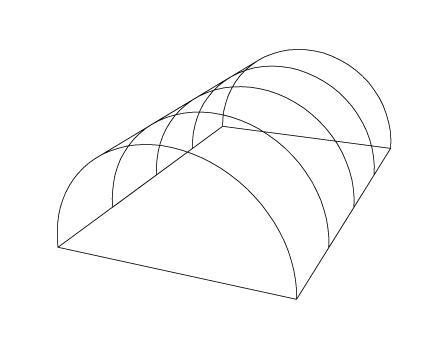|
Diaphragm Arch
A diaphragm arch is a transverse wall-bearing arch forming a partial wall dividing a vault or a ceiling into compartments while also bracing the walls. When used under a wooden roof (with solid spandrels) it has the advantage of providing a partial firebreak. It was first used in Roman Syria, during the 2nd century AD. The diaphragm arch is present in Islamic, Carolingian, Ottonian and Romanesque architecture. See also * Islamic architecture * Romanesque architecture Romanesque architecture is an architectural style of medieval Europe that was predominant in the 11th and 12th centuries. The style eventually developed into the Gothic style with the shape of the arches providing a simple distinction: the Ro ... * Kucheh References Sources * Arches and vaults {{Architecturalelement-stub ... [...More Info...] [...Related Items...] OR: [Wikipedia] [Google] [Baidu] [Amazon] |
Diaphragm Arch, South East Tower, Beaumaris Castle
Diaphragm may refer to: Anatomy * Thoracic diaphragm, a thin sheet of muscle between the thorax and the abdomen * Pelvic diaphragm or pelvic floor, a pelvic structure * Urogenital diaphragm or triangular ligament, a pelvic structure Other * Diaphragm (optics), a stop in the light path of a lens, having an aperture that regulates the amount of light that passes * Diaphragm (acoustics), a thin, semi-rigid membrane that vibrates to produce or transmit sound waves * Diaphragm (birth control), a small rubber dome placed in the vagina to wall off the cervix, thus preventing sperm from entering * Diaphragm (mechanical device), a sheet of a semi-flexible material anchored at its periphery * Diaphragm (structural system), a structural engineering system used to resist lateral loads See also * Diaphragm arch * Diaphragm pump * Diaphragm seal, a membrane that seals an enclosure * Diaphragm shutter, a type of leaf shutter consisting of a number of thin blades in a camera * Diaphragm valve * ... [...More Info...] [...Related Items...] OR: [Wikipedia] [Google] [Baidu] [Amazon] |
Transverse Arch
In architecture, a transverse arch is an arch in a vaulted building that goes across the barrel vault. A series of transverse arches sitting on tops of the columns on the sides of the nave was typical in the churches of Romanesque architecture (common since Carolingian times). By analogy, the term is also used to describe the transverse ribs of a groined vault and for any crosswise arch in modern buildings. An arc that goes in transverse direction, but carries an exposed wall on top, dividing the vault into compartments, is called a diaphragm arch. In the historical buildings, the transverse arches provide support for purlins and roof ridge beams. They also subdivide the nave into bays. The springings of the arch are typically pinned to supports using wooden or steel ties, but the bulk of lateral thrust is terminated in the abutments. File:Kerkplattegrond gordelboog en travee.png, The transverse arches are highlighted in green on a plan of a church File:Voûte en berceau C ... [...More Info...] [...Related Items...] OR: [Wikipedia] [Google] [Baidu] [Amazon] |
Arch
An arch is a curved vertical structure spanning an open space underneath it. Arches may support the load above them, or they may perform a purely decorative role. As a decorative element, the arch dates back to the 4th millennium BC, but structural load-bearing arches became popular only after their adoption by the Ancient Romans in the 4th century BC. Arch-like structures can be horizontal, like an arch dam that withstands the horizontal hydrostatic pressure load. Arches are usually used as supports for many types of vaults, with the barrel vault in particular being a continuous arch. Extensive use of arches and vaults characterizes an arcuated construction, as opposed to the trabeated system, where, like in the architectures of ancient Greece, China, and Japan (as well as the modern steel-framed technique), posts and beams dominate. Arches had several advantages over the lintel, especially in the masonry construction: with the same amount of material it can have ... [...More Info...] [...Related Items...] OR: [Wikipedia] [Google] [Baidu] [Amazon] |
Vault (architecture)
In architecture, a vault (French ''voûte'', from Italian ''volta'') is a self-supporting arched form, usually of stone or brick, serving to cover a space with a ceiling or roof. As in building an arch, a temporary support is needed while rings of voussoirs are constructed and the rings placed in position. Until the topmost voussoir, the Keystone (architecture), keystone, is positioned, the vault is not self-supporting. Where timber is easily obtained, this temporary support is provided by centering consisting of a framed truss with a semicircular or Circular segment, segmental head, which supports the voussoirs until the ring of the whole arch is completed. The Mycenaean Greece, Mycenaeans (ca. 18th century BC, 1800–1050s BC, 1050 BC) were known for their Tholos (architecture), tholos tombs, also called beehive tombs, which were underground structures with conical vaults. This type of vault is one of the earliest evidences of curved brick architecture without the use of ston ... [...More Info...] [...Related Items...] OR: [Wikipedia] [Google] [Baidu] [Amazon] |
Ceiling
A ceiling is an overhead interior roof that covers the upper limits of a room. It is not generally considered a structural element, but a finished surface concealing the underside of the roof structure or the floor of a story above. Ceilings can be decorated to taste, and there are many examples of frescoes and artwork on ceilings, especially within religious buildings. A ceiling can also be the upper limit of a tunnel. The most common type of ceiling is the dropped ceiling, which is suspended from structural elements above. Panels of drywall are fastened either directly to the ceiling joists or to a few layers of moisture-proof plywood which are then attached to the joists. Pipework or ducts can be run in the gap above the ceiling, and insulation and fireproofing material can be placed here. Alternatively, ceilings may be spray painted instead, leaving the pipework and ducts exposed but painted, and using spray foam. A subset of the dropped ceiling is the suspended ceiling, ... [...More Info...] [...Related Items...] OR: [Wikipedia] [Google] [Baidu] [Amazon] |
Spandrel
A spandrel is a roughly triangular space, usually found in pairs, between the top of an arch and a rectangular frame, between the tops of two adjacent arches, or one of the four spaces between a circle within a square. They are frequently filled with decorative elements. Meaning There are four or five accepted and cognate meanings of the term ''spandrel'' in architecture, architectural and art history, mostly relating to the space between a curved figure and a rectangular boundary – such as the space between the curve of an arch and a rectilinear bounding moulding, or the wallspace bounded by adjacent arches in an arcade and the stringcourse or moulding above them, or the space between the central medallion of a carpet and its rectangular corners, or the space between the circular face of a clock and the corners of the square revealed by its hood. Also included is the space under a flight of stairs, if it is not occupied by another flight of stairs. In a building with more ... [...More Info...] [...Related Items...] OR: [Wikipedia] [Google] [Baidu] [Amazon] |
Firebreak
A firebreak or double track (also called a fire line, fuel break, fireroad and firetrail in Australia) is a gap in vegetation or other combustible material that acts as a barrier to slow or stop the progress of a bushfire or wildfire. A firebreak may occur naturally where there is an absence of vegetation or "fuel", such as a river, lake or canyon. Firebreaks may also be man-made, and many of these also serve as roads, such as logging roads, four-wheel drive trails, secondary roads, or highways. Overview In the construction of a firebreak, the primary goal is to remove deadwood and undergrowth down to mineral soil. Various methods may be used to accomplish this initially and to maintain this condition. Ideally, the firebreak will be constructed and maintained according to the established practices of sustainable forestry and fire protection engineering, also known as best management practices (BMP). The general goals are to maximize the effectiveness of the firebreak at slowin ... [...More Info...] [...Related Items...] OR: [Wikipedia] [Google] [Baidu] [Amazon] |
Islamic Architecture
Islamic architecture comprises the architectural styles of buildings associated with Islam. It encompasses both Secularity, secular and religious styles from the early history of Islam to the present day. The Muslim world, Islamic world encompasses a wide geographic area historically ranging from western Africa and Europe to eastern Asia. Certain commonalities are shared by Islamic architectural styles across all these regions, but over time different regions developed their own styles according to local materials and techniques, local dynasties and patrons, different regional centers of artistic production, and sometimes Islamic schools and branches, different religious affiliations. Early Islamic architecture was influenced by Roman architecture, Roman, Byzantine architecture, Byzantine, Iranian architecture, Iranian, and Architecture of Mesopotamia, Mesopotamian architecture and all other lands which the early Muslim conquests conquered in the seventh and eighth centuries.: "As ... [...More Info...] [...Related Items...] OR: [Wikipedia] [Google] [Baidu] [Amazon] |
Carolingian Architecture
Carolingian architecture is the style of north European Pre-Romanesque architecture belonging to the period of the Carolingian Renaissance of the late 8th and 9th centuries, when the Carolingian dynasty dominated west European politics. It was a conscious attempt to emulate Roman architecture and to that end it borrowed heavily from Early Christian and Byzantine architecture, though there are nonetheless innovations of its own, resulting in a unique character. The gatehouse of the monastery at Lorsch, built around 800, exemplifies classical inspiration for Carolingian architecture, built as a triple-arched hall dominating the gateway, with the arched facade interspersed with attached classical columns and pilasters above. The Palatine Chapel in Aachen constructed between 792–805 was inspired by the Emperor Justinian's octagonal San Vitale in Ravenna, built in the 6th century. At Aachen there is a tall monumental western entrance complex, as a whole called a westwo ... [...More Info...] [...Related Items...] OR: [Wikipedia] [Google] [Baidu] [Amazon] |
Ottonian Architecture
Ottonian architecture is an architectural style which evolved during the reign of Emperor Otto the Great. The style was found in Germany and lasted from the mid 10th century until the mid 11th century. History Ottonian architecture draws its inspiration from Carolingian and Byzantine architecture. Ottonian architecture also draws from Christian art. This style of architecture is an example of a combination of Christian architecture as well as Germanic and Mediterranean styles. So influenced by Carolingian architecture, Otto I even transported marble columns from Italy to use in his churches in Germany. Though it has very similar characteristics to Carolingian architecture, the difference is in the Ottonian architects who used classical elements in state of the art ways to create what is known as Ottonian architecture. Apart from some examples influenced by the octagonal Palatine Chapel at Aachen such as Ottmarsheim (11th century, Alsace) and the apse of the abbey of the Holy Tr ... [...More Info...] [...Related Items...] OR: [Wikipedia] [Google] [Baidu] [Amazon] |
Romanesque Architecture
Romanesque architecture is an architectural style of medieval Europe that was predominant in the 11th and 12th centuries. The style eventually developed into the Gothic style with the shape of the arches providing a simple distinction: the Romanesque is characterized by semicircular arches, while the Gothic is marked by the pointed arches. The Romanesque emerged nearly simultaneously in multiple countries of Western Europe; its examples can be found across the continent, making it the first pan-European architectural style since Imperial Roman architecture. Similarly to Gothic, the name of the style was transferred onto the contemporary Romanesque art. Combining features of ancient Roman and Byzantine buildings and other local traditions, Romanesque architecture is known by its massive quality, thick walls, round arches, sturdy pillars, barrel vaults, large towers and decorative arcading. Each building has clearly defined forms, frequently of very regular, symmetrical ... [...More Info...] [...Related Items...] OR: [Wikipedia] [Google] [Baidu] [Amazon] |







